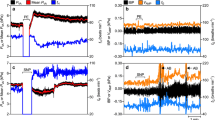Summary
-
1.
The function of ventilatory pauses in the crab,Cancer pagurus, was investigated by analyzing pre- and postbranchial hemolymph, sampled via chronic indwelling catheters before, during and after pauses.
-
2.
Evidence is presented that aerobic metabolism declines when ventilation ceases and that hemolymph O2 stores are nearly depleted during a typical pause.
-
3.
At 10° C and 34‰ salinity, hemocyanin has a low O2 affinity (P 50=9 Torr at pH 7.96) and a large, normal Bohr shift (ΔlogP 50/ΔpH=−0.95). The cooperativity between O2 binding sites is high (n 50=3.5).
-
4.
It is suggested that pausing behavior serves to optimize the expenditure of energy during periods of non-activity by calling on O2 stores built up during ventilating periods.Cancer pagurus accomplishes this by nearly completely saturating its low O2 carrying capacity hemolymph with O2. Having a large hemolymph volume and highP O 2 in the venous hemolymph pool are obvious advantages.
Similar content being viewed by others
References
Ansell AD (1973) Changes in oxygen consumption, heart rate and ventilation accompanying starvation in the decapod crustaceanCancer pagurus. Neth J Sea Res 7:455–475
Astrup P (1956) A simple electrometric technique for the determination of carbon dioxide tension in blood and plasma, total content of carbon dioxide in plasma and bicarbonate content in “separated” plasma at a fixed carbon dioxide tension (40 mm Hg). Scand J Clin Lab Invest 8:33–43
Batterton CV, Cameron JN (1978) Characteristics of resting ventilation and response to hypoxia, hypercapnia and emersion in the blue crab,Callinectes sapidus (Rathbun). J Exp Zool 203:403–418
Bridges CR (1979) Adaptations ofCorystes cassivelannus to an arenicolous mode of life. In: Naylor E, Hartnoll RG (eds) Cyclic phenomena in marine plants and animals. Pergamon Press, Oxford New York, pp 317–324
Bridges CR, Brand AR (1980) The effect of hypoxia on oxygen consumption and blood lactate levels of some marine crustacea. Comp Biochem Physiol [A] 65:399–409
Bridges CR, Bicudo JEPW, Lykkeboe G (1979) Oxygen content measurement in blood containing haemocyanin. Comp Biochem Physiol [A] 62:457–462
Butler PJ, Taylor EW, McMahon BR (1978) Respiratory and circulatory changes in the lobster (Homarus vulgaris) during long term exposure to moderate hypoxia. J Exp Biol 73:131–146
Burnett LE (1979) The effects of environmental oxygen levels on the respiratory function of hemocyanin in the crabs,Libinia amarginata andOcypode quadrata. J Exp Zool 210:289–300
Burnett LE, Johansen K (1981) The role of branchial ventilation in blood acid-base changes in the shore crab,Carcinus maenas, during hypoxia. J Comp Physiol 141:489–494
Dejours P (1975) Principles of comparative respiratory physiology. American Elsevier, New York, p 253
Florey E, Kriebel ME (1974) The effects of temperature, anoxia and sensory stimulation on the heart rate of unrestrained crabs. Comp Biochem Physiol [A] 48:285–300
Gleeson RA, Zubkoff RL (1977) The determination of hemolymph volume in the blue crab,Callinectes sapidus utilizing14C-thiocyanate. Comp Biochem Physiol [A] 56:411–413
Helm MM, Trueman ER (1967) The effect of air exposure on the heart rate of the mussel,Mytilus edulis L. Comp Biochem Physiol 21:171–177
Houlihan DF, Duthie G, Smith P, Talbot C (1980) In situ sampling of crab blood by scuba divers. J Exp Mar Biol Ecol 45:219–228
Hughes GM, Knights B, Scammell CA (1969) The distribution of PO 2 and hydrostatic pressure changes within the branchial chambers in relation to gill ventilation of the shore crabCarcinus maenas L. J Exp Biol 51:203–220
Johansen K, Lenfant C, Mecklenburg TA (1970) Respiration in the crab,Cancer magister. Z Vergl Physiol 70:1–19
Lykkeboe G, Johansen K, Maloiy GMO (1975) Functional properties of hemoglobins in the teleostTilapia grahami. J Comp Physiol 104:1–11
Mangum CP (1980) Respiratory function of the hemocyanins. Am Zool 20:19–38
McDonald DG, McMahon BR, Wood CM (1977) Patterns of heart and scaphognathite activity in the crabCancer magister. J Exp Zool 202:33–34
McMahon BR, Wilkens JL (1972) Simultaneous apnoea and bradycardia in the lobsterHomarus americanus. Can J Zool 50:165–170
McMahon BR, Wilkens JL (1975) Respiratory and circulatory responses to hypoxia in the lobsterHomarus americanus J Exp Biol 62:637–655
McMahon BR, Wilkens JL (1977) Periodic respiratory and circulatory performance in the red rock crabCancer productus. J Exp Zool 202:363–374
McMahon BR, Butler PJ, Taylor EW (1978) Acid-base changes during recovery from disturbance and during long-term hypoxic exposure in the lobsterHomarus vulgaris. J Exp Zool 205:361–370
Mcmahon BR, McDonald DG, Wood CM (1979) Ventilation, oxygen uptake and hemolymph oxygen transport following enforced exhausting activity in the Dungeness crabCancer magister. J Exp Biol 80:271–285
Sick H, Gersonde K (1969) Methods for continous registration of O2-binding curves of haemo-proteins by means of a diffusion chamber. Anal Biochem 32:362–376
Truchot JP (1971) Etude comparée de la fixation de l'oxygène par le sérum de cinq espèces de Crustacés Décapodes Brachyoures. CR Acad Sci (Paris) 272:2706–2709
Truchot JP (1976) Carbon dioxide combining properties of the blood of the shore crabCarcinus maenas (L.): Carbon dioxide solubility coefficient and carbonic acid dissociation constants. J Exp Biol 64:45–57
Tucker VA (1967) Method for oxygen content and dissociation curves on microliter blood samples. J Appl Physiol 23:410–414
Wilkens JL (1976) Neuronal control of respiration in decapod crustacea. Fed Proc 35:2000–2006
Wilkens JL, Wilkens LA, McMahon BR (1974) Central control of cardiac and scaphognathite pacemakers in the crabCancer magister. J Comp Physiol 90:89–104
Author information
Authors and Affiliations
Rights and permissions
About this article
Cite this article
Burnett, L.E., Bridges, C.R. The physiological properties and function of ventilatory pauses in the crabCancer pagurus . J Comp Physiol B 145, 81–88 (1981). https://doi.org/10.1007/BF00782597
Accepted:
Issue Date:
DOI: https://doi.org/10.1007/BF00782597




